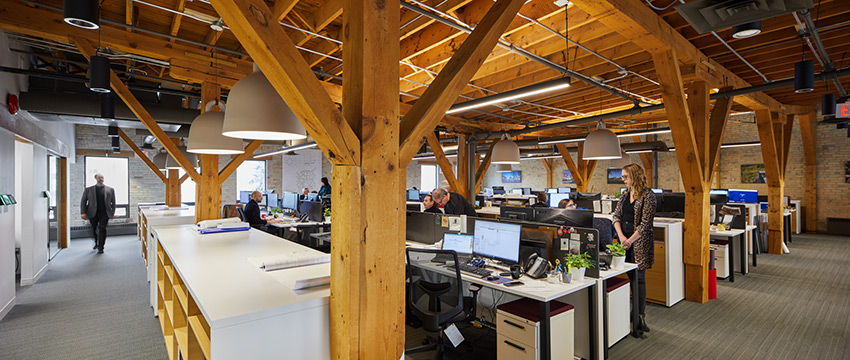
By Ivy Bricker, Professional Interior Designer
As the days, weeks and months pass by, it has been too long since I have been at my desk at the Number TEN Office. Not that I am counting or anything, but I miss coming into the office each and every day. Since working from home, a lot of questions have been weighing heavily on me. When will we return to the workplace? What exactly will it look and feel like? I know it will not be the same office I left back in March. I start to look at the bigger picture, trying to understand the long-term effects for the future of workplace design.

Image: Number TEN open work area
I am part of the Workplace Studio at Number TEN and was part of the team who designed our recently renovated office last year. We pushed the boundaries moving our office into a more open, shared work environment with self-select spaces for meeting, featuring a central workplace café for informal group gatherings. The open social hub was surrounded by more focused head down areas for production with breakout spaces nearby for smaller one on one meetings.

Images: Reception | Café | Fourth floor collaboration space
I feel confident that the importance of these shared social spaces so pivotal in our office renovation will not disappear, but the use and function will simply shift. After recently attending a conference digitally from Neocon discussing reoccupying and assessing workplaces, Tom Zurowski (founding principal of Eastlake Studio in Chicago) highlighted three themes that he felt emerged to help define what the future of workplace design will focus on: culture, flexibility and wellness. ![]() Culture: There is something to be said about workplace culture and what it means to engage with a space that speaks to an organizations’ values and goals. I think in looking towards the future of workplace design, there will be a greater understanding that nothing can replace face to face meetings. As not all meetings can be planned, rather interactions and conversations can occur organically by chance. This type of collaboration has shifted, as it will need to go hand in hand with more digital interfaces. We do not want to lose the advantages we have learnt working from home, and what we have experienced over the last few months. Rather our workplaces will begin to highlight and change in focus to celebrate the ways we successfully worked remotely, bringing people back to the office to commemorate what it stands for, a space to collaborate and work together in person, fostering connections.
Culture: There is something to be said about workplace culture and what it means to engage with a space that speaks to an organizations’ values and goals. I think in looking towards the future of workplace design, there will be a greater understanding that nothing can replace face to face meetings. As not all meetings can be planned, rather interactions and conversations can occur organically by chance. This type of collaboration has shifted, as it will need to go hand in hand with more digital interfaces. We do not want to lose the advantages we have learnt working from home, and what we have experienced over the last few months. Rather our workplaces will begin to highlight and change in focus to celebrate the ways we successfully worked remotely, bringing people back to the office to commemorate what it stands for, a space to collaborate and work together in person, fostering connections. ![]() Flexibility: A focus will be placed on both temporary and permanent solutions to provide social distancing spaces that can move and adapt. A fluid approach here is what our future of workplace design may look like, as more furniture focused modular aspects can be implemented to help create a flexible space to meet 6’ distancing regulations. There is a short-term focus on the return to work and the need for more boundaries or dividers amongst open work areas driven by the science-based facts we rely on. The longer-term solutions may illustrate a more flexible, modular, and adaptable response to redefining space if needed, from a more data driven understanding of how spaces can conform and adjust if required.
Flexibility: A focus will be placed on both temporary and permanent solutions to provide social distancing spaces that can move and adapt. A fluid approach here is what our future of workplace design may look like, as more furniture focused modular aspects can be implemented to help create a flexible space to meet 6’ distancing regulations. There is a short-term focus on the return to work and the need for more boundaries or dividers amongst open work areas driven by the science-based facts we rely on. The longer-term solutions may illustrate a more flexible, modular, and adaptable response to redefining space if needed, from a more data driven understanding of how spaces can conform and adjust if required. ![]() Wellness: A key focus was already placed in workplace design on the need for spaces that evoke wellness, interior environments that promote healthier lifestyles and improved options for amenities. There will be an acceleration of the concept of wellness focusing on the perception of cleanliness, materiality, and safe spaces. As designers we need to understand how the use of shared spaces and cleaning may affect the function and use of these shared amenities and start to design for a smaller density using these spaces. The future of cleaning protocols provides the perception of cleaner and healthier spaces, but also maybe helps create visible markers for sanitization, making staff more comfortable in an open work environment. The future of design will question high traffic and high contact areas and the surfaces used.
Wellness: A key focus was already placed in workplace design on the need for spaces that evoke wellness, interior environments that promote healthier lifestyles and improved options for amenities. There will be an acceleration of the concept of wellness focusing on the perception of cleanliness, materiality, and safe spaces. As designers we need to understand how the use of shared spaces and cleaning may affect the function and use of these shared amenities and start to design for a smaller density using these spaces. The future of cleaning protocols provides the perception of cleaner and healthier spaces, but also maybe helps create visible markers for sanitization, making staff more comfortable in an open work environment. The future of design will question high traffic and high contact areas and the surfaces used.
As interior designers we are always questioning and pushing boundaries of spaces, volumes, and materiality. No matter what the future of workplace design holds, we are shifting our understanding and meaning of culture and connection. This means considering the flexibility of our interior spaces and what it means to adapt temporary or permanent modular solutions, and considering the awareness of healthy and clean environments that promote wellness.
Ivy is an Interior Designer at Number TEN Architectural Group